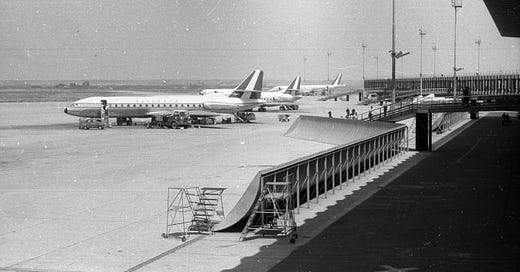This post wraps up our discussions to do with Sustainable Aviation Fuels (SAFs). Previous posts in the series are:
World-wide aviation accounts for 2.5% of global CO2 emissions. The industry is under pressure to reduce their emissions ― the goal of ‘Net Zero by 2050’ is often proposed.
The fuel that the industry currently uses is kerosene/Jet A. It is energy dense and easily handled. SAFs are the only realistic ‘green’ replacement.
As we have seen, the basic idea behind Sustainable Aviation Fuels is that they are biofuels manufactured from plant materials such as corn. The crop absorbs carbon dioxide (CO2) as it grows. When the SAF is burned in an airplane’s engine it creates an equivalent amount of CO2 that is emitted to the atmosphere and then ‘recycled’ by the growing crops. It is this overall process that is deemed to be sustainable. The use of SAFs does not reduce the amount of greenhouse gases emitted by the aviation industry ― it merely stabilizes the current levels of those gases in the atmosphere. (Hence the ‘Net’ in ‘Net Zero’.) Claims that the technology reduces greenhouse gas emissions are disingenuous.
Commercial test flights have demonstrated that SAFs can be used safely. Nevertheless, it is questionable that these fuels will be an effective one-for-one replacement of conventional jet fuel. Some of the difficulties that we have discussed in previous posts include the following.
Economics
SAFs are more expensive than conventional fuels.Blending
So far, the SAFs that have been used are actually mixtures that contain at least 50% conventional jet fuel. ‘Pure’ SAFs have not yet been used in commercial flights. There are regulatory hurdles to be cleared.
Land Use
Enormous amounts of land will be needed to grow the crops that are used to manufacture the SAFs. That same land is needed to grow food.Scale
Like most other ‘green’ energy solutions, SAFs are still at the demonstration stage. A vast and expensive infrastructure will be needed to fully commercialize the technology. If the year 2050 is set as the deadline, then there is insufficient time available to make the needed investment.Manufacturing Energy Use
The manufacture of SAFs using technologies such as the Ficher-Tropsch process uses large quantities of energy supplied by fossil fuels. If the associated emissions are included, SAFs are not CO2 neutral.
The civil aviation industry in its present form started in the 1960s. Prior to that date air travel was confined mostly to wealthy people who were not too risk averse. According to IEA data, in 1980 the number of passengers world-wide was 0.8 billion. By the year 2019 (immediately prior to COVID) that number had risen to 4.6 billion. The only way that the industry can maintain that passenger volume and also achieve Net Zero goals is to implement the manufacture of SAFs at an unprecedented pace. This would, of course, have the side effect of drastically raising ticket prices.
So the industry, and society in general, is faced with three choices.
Continue with Business as Usual, i.e., maintain current passenger volumes and accept the global warming consequences.
Spend enormous amounts of money on SAF technology. These costs will have to be recovered through higher ticket prices, which it is assumed that passengers will be willing to pay because air travel is so important to them. (This seems unlikely ― after all, most flying is a discretionary activity.)
Reduce the size of the business to what it was in the 1960s.
Not only is this a dilemma for the civil aviation industry, the same choices face many other industrial and commercial activities.






